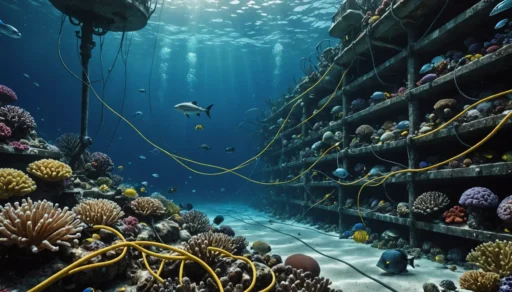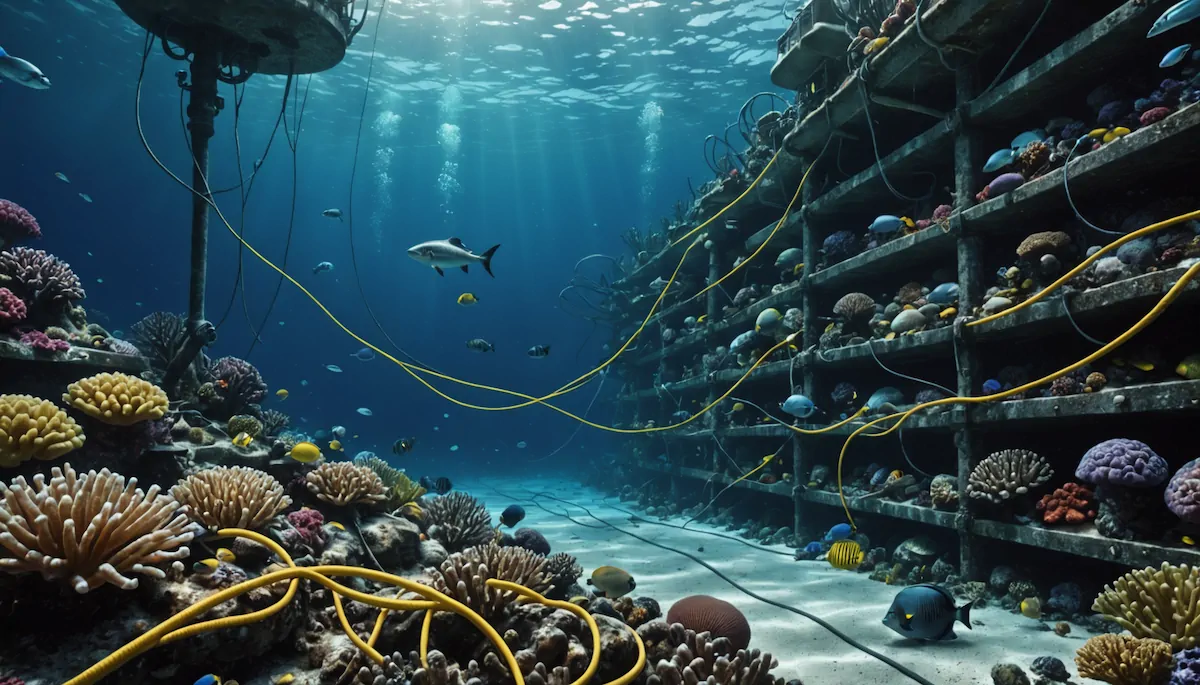The Underwater Lifelines That Keep AI Running Everywhere
Everyone’s talking about AI—what it can do, what it might do, what it should never do. But underneath all that buzz, there’s something most people never see: the physical network hauling massive datasets across oceans, at the speed of light, 24/7. We’re talking about undersea cables, the invisible infrastructure running underneath your chatbot answers, remote video edits, and cloud-based medical diagnostics.
AI isn’t just software anymore. It’s becoming our utility layer—the thing powering industries, decisions, and economies. And it’s hungry. Really hungry. Models like GPT-4 demand lightning-fast, ultra-reliable access to data. You can’t get that without high-capacity global networks.
That’s why big tech is pouring billions into glass threads stretching from New York to Mumbai. As AI scales, these cables aren’t back-end plumbing—they’re front-line weapons. No bandwidth, no AI intelligence. It’s that simple.
And while tech giants boast about “edge computing” and “zero-latency inference,” someone still has to bury cables thousands of miles long beneath shark-infested waters and tectonic ridges. So let’s get blunt about what’s really moving the AI revolution—glass, fiber, and force.
AI’s Growing Appetite Meets Global Bandwidth Limits
When algorithms need to think fast, your network better move faster. AI applications aren’t lightweight—especially with real-time use cases like autonomous vehicles, fraud detection, or large-scale language modeling. We’re not talking megabytes. We’re talking petabytes a day.
You’ve seen the headlines: new models, better AI, smarter devices. But behind each upgrade sits a brutal truth—models double in size while the data load triples. Traffic needs low latency, massive bandwidth, and guaranteed uptime across continents.
Here’s what that looks like on the ground:
- AI inference demands faster round-trip data processing in milliseconds—not seconds.
- Training runs involve multi-region coordination across U.S., EU, and Asia data centers.
- Real-time voice, video, and vision inputs from edge devices require split-second accuracy.
That kind of demand smashes into current submarine cable limitations—unless companies upgrade their digital backbone. Which they are.
The Billion-Dollar Cables Powering the AI Surge
Let’s talk numbers. Meta’s Project Waterworth isn’t a cute experiment—it’s a 50,000 km transoceanic megastructure linking the U.S., India, Brazil, South Africa, and Europe. That’s the longest subsea cable project ever planned.
Why? Because their AI systems need low-latency training across global data centers. Meta is building its own infrastructure to enable that, bypassing volatile zones like the South China Sea to avoid geopolitical choke points.
They’re not alone:
| Company | Key Cable Project | Route | Capacity |
|---|---|---|---|
| Grace Hopper | New York to UK/Spain | 340 Tbps | |
| Meta | Project Waterworth | Global (U.S. to India, Brazil, Africa, Europe) | N/A (multi-terabit expected) |
| Telstra | Network Upgrade | Pacific Region | To 800 Tbps by 2025 |
These projects signal a new paradigm: hyperscalers don’t want to rent bandwidth—they want to own it, shape it, and weaponize it for AI dominance.
Fiber Optics And Their Role In AI-Ready Infrastructure
So how does all this data move fast enough to beat latency thresholds? Fiber optics—refined to ballistic levels.
Old-school Ethernet isn’t making transatlantic runs with 1 terabit-per-second clarity. We’re talking about cutting-edge coherent optics—AKA algorithms riding laser-light signals over thousand-mile stretches.
Advanced optical systems are now pushing 800Gbps to 1Tbps across ocean floors. That’s fast enough to:
- Connect global GPU clusters without info lag
- Streamline federated learning across nations
- Make cloud-based AI purely reactive, not sluggish
And let’s be clear, this isn’t just about speed. It’s about upgrading the cloud’s nervous system, making it responsive enough for AI to not just make decisions—but make millions per second.
Fiber isn’t just infrastructure anymore. It’s competitive leverage.
Meta is betting on cables for AI parity. Google’s already there. Telstra’s retooling its Pacific corridor with digital twins and AI systems from Ciena for fault prediction and rerouting. The future of intelligent systems lives and dies by glass threads sliding beneath the sea.
Forget floating data—AI’s rise is etched in silica, miles underwater.
The Power Shift: Hyperscalers Vs. Telcos
Let’s end with the obvious flex: the cloud isn’t in the clouds. It’s under oceans. And the players who own the cable routes own the future of artificial intelligence.
Google, Meta, and Amazon now control more than 60% of new subsea cable projects. Traditional telecoms? They’re being leapfrogged hard.
Owning the pipe means:
– Predictable bandwidth (no leasing from legacy carriers)
– Prioritized traffic for compute-hungry AI workloads
– Geopolitical independence in strategic regions
That’s why we’re seeing private AI cables stretch between select mega-data centers—no detours, no peering points, just direct, high-speed fiber paths.
When your AI needs to think in 20 milliseconds or less, you don’t let the traffic fight through 18 routers and 4 ISPs.
And when training your model costs more than an apartment complex, you don’t trust it to the general internet.
This is no longer about connectivity. It’s about control.
And [this infrastructure shift](https://www.networkworld.com/article/3676358/how-ai-is-driving-the-next-wave-of-subsea-cable-investment.html) is how big tech keeps AI—and the profits—moving at full throttle.
Challenges and Vulnerabilities in AI Data Infrastructure
What happens when AI’s hunger for data meets a network that was never built to feed it?
That’s not a theoretical question. It’s what telecoms across the globe are facing as AI model training, real-time inference, and growing cloud usage put pressure on submarine data cables—those quiet titans that carry 95% of international internet traffic beneath the seafloor.
Increased Pressure on Submarine Cables due to AI Scaling
The problem isn’t so much the cables breaking—though that happens too—it’s that they’re running out of room. Right now, the typical backbone link runs at about 400Gbps, barely enough to support the kind of AI workloads being spun up by Meta, Google, OpenAI, and their geopolitical counterparts.
Telstra, a major Australian telco, is feeling these growing pains. They’ve announced a plan to triple capacity on their Asia-Pacific undersea cable network by 2025. Why? Because existing links can’t keep up with the projected data traffic—set to triple by 2030, all thanks to AI systems demanding real-time global coordination between data centers.
At the same time, hyperscalers like Meta aren’t waiting around. Their “Project Waterworth” cable—spanning 50,000 kilometers—connects five continents and skips political flashpoints like the South China Sea. It’s not about connecting people. It’s about feeding LLMs.
Vulnerabilities and Risks to Submarine Networks
Cables don’t just bottleneck—they break. Sometimes by accident (earthquakes or shifting seabeds), and sometimes on purpose. In 2024, incidents in the Baltic Sea and near Taiwan saw cables deliberately severed—allegedly by disguised vessels using underwater drones. NATO didn’t just file a complaint; they formed a specialized task force for cable defense. That’s how serious it’s gotten.
Sabotage isn’t the only threat. Researchers and defense agencies alike warn that data carried over long subsea routes could be intercepted. And if you think “end-to-end encryption” always works, ask military strategists why submarines started trailing telecom cables during the Cold War.
Windward, a maritime AI security firm, now uses real-time machine learning to flag AIS (ship location) spoofing—a red flag for potential cable-tapping activity. But here’s the irony: we’re using AI to defend the cables AI is stressing to the brink.
Environmental fallout also gets buried—literally. Each repeater unit on a cable consumes about 3kW of power. Multiply that by thousands of units over decades, and you’ve locked in a secret carbon sink beneath the ocean.
Economic and Social Implications of Data Infrastructure Gaps
When an AI model needs a split-second to respond but the nearest data center is on another continent, guess who won’t enjoy flawless performance? Regions like sub-Saharan Africa, Southeast Asia, and parts of Latin America often sit on the wrong side of cable maps and the AI divide.
Google’s Equiano and Meta’s 2Africa projects claim to offer a 100x boost in African network capacity, but it’s not evenly distributed. A port city might flourish thanks to hyperscale-ready landing stations, while rural areas remain stuck with pre-AI era latency.
Without equitable backbone infrastructure, AI becomes a luxury toy of the wired elite—a digital arms race for privileged regions. And as more essential services (education, healthcare, disaster response) go AI-first, connectivity gaps become social inequality gaps.
So when industry leaders pitch AI as global progress, it’s fair to ask: progress for whom?
Innovations Supporting AI-Friendly Data Networks
As the world’s AI engines grow hungrier, the systems feeding them are evolving too. New tech—from coherent optics to AI-managed traffic—is flipping the script on how we move data across oceans and continents.
Adoption of Advanced Technologies in Subsea Cables
Innovation isn’t just happening in cloud servers; it’s in the cables themselves. Operators like Telstra are baking in predictive intelligence with the use of digital twins—virtual clones used to model and monitor their entire network in real time. That means faults get detected before outages hit, a critical need for AI systems that can’t afford delays.
Inside hyperscaler data centers, spine-and-leaf cable architectures are making latency a thing of the past by minimizing data hop counts. It’s the architectural backbone AI needed but never had in the era of serial processing workflows.
The Rise of Edge Computing and its Influence on Undersea Cable Expansion
AI doesn’t just want bandwidth—it wants proximity. Edge compute architectures bring processing power closer to where data’s generated, and that reshapes where cables land. Instead of anchoring just to traditional metro hubs, fiber now runs to distributed “edge zones” closer to sensor networks, vehicles, and remote devices demanding real-time responses.
These changes aren’t theoretical. They dictate how new submarine cables get routed, how energy is distributed across regions, and how fast something like autonomous driving will work in Dakar versus Detroit.
Redefining Speed and Scalability with Coherent Optics
The biggest breakthrough in recent cable tech? Coherent optics. These optical engines can push data transmissions to 800Gbps, even 1Tbps—crucial for hyperscale AI pipelines that move massive model weights between training nodes spread across oceans.
Google’s Dunant and Grace Hopper cables are already showing what fully-optimized coherent optics achieve: near-zero packet loss, ultra-low latency, and performance tuned for AI, not traditional web services. With the rise of multimodal models feeding on audio, video, and sensor data—speed isn’t just nice to have. It’s existential for functionality.
Enhancing AI Resilience with AI/ML-Aided Network Management
What manages AI’s infrastructure? Increasingly, other AI models.
Telcos are deploying machine learning tools to reroute overloaded paths in seconds, instead of relying on manual models delayed by human oversight. Telstra uses AI-enhanced fiber monitoring to detect micro-vibrations—anomalies that would otherwise go unnoticed until failure.
:
- Self-healing networks: Predict where faults are likely and reroute before customers notice.
- AI-as-Defender: Flag suspicious movements near cables in politically sensitive maritime zones.
It’s cyber-immune design—because if AI is going to make life-critical decisions, its data plumbing better be bulletproof, self-aware, and fast enough to keep up with itself.
And make no mistake: this capacity isn’t just future-proofing. It’s survival-proofing.
The Future of AI-Driven Infrastructure Expansion
Predicted Growth of Global Data Traffic
Let’s be real—AI isn’t just disrupting the digital world. It’s bulldozing straight through internet infrastructure itself. And most folks have no clue how much horsepower tomorrow’s AI will need.
Global data traffic is predicted to triple by 2030, not because of your Netflix binge habits, but because AI models now move more data across borders than banks move cash. These models don’t run in isolation—they rely on distributed, high-speed data flows between massive clusters positioned across continents to train, fine-tune, and deploy globally. And that data doesn’t float in the cloud; it travels on real, physical cables underwater.
What’s fueling this surge? AI training runs. LLMs (like GPT-whatever version we’re on now) are stacking up parameters and ingesting datasets that outweigh public libraries. Every AI photo filter, fraud detection algorithm, and video recommendation engine adds pressure onto these undersea wires. Right now, 400Gbps is the baseline… but we’re quickly inching toward 800Gbps and even 1Tbps via advanced coherent optics. Slow is dead. Latency kills inference.
So yeah—AI isn’t “just software.” It’s eating bandwidth for breakfast.
Regional Developments in Data Infrastructure
You want to see what the future looks like? Don’t look at Silicon Valley—look south. Africa and the MENA region are experiencing the kind of infrastructure boom that rewrites economic destinies. Just ask the teams behind the 2Africa and Equiano cables: they’re laying down data highways that boost regional capacity by 100x. Not hyperbole. Real hundredfold increases.
We’re talking about fiber stretching around the continent, stitching together markets that had been digitally isolated. Nigeria to Kenya, Morocco to South Africa—leapfrogging old landline limitations straight into the global AI arena. These aren’t just cables. They’re arteries.
In the Middle East and North Africa, 15+ new subsea cables are being installed over 2024–25. That’s a big shift from being pass-through land to becoming initiators of AI-centric services. And yes, the hyperscalers are behind a lot of it—Google, Meta, and Amazon are now telecom players whether the telcos like it or not.
Undersea fiber is power. And right now, it’s being bought, sold, and built faster in the Global South than most of the West expected.
Geopolitical Considerations in the Data Race
Let’s talk war—not with guns, but with backhoes and spoofed transponders. The geopolitical importance of AI data cables has reached naval-intelligence levels. Literally. When undersea cables got sliced between Finland and Estonia last year, NATO didn’t issue a press release. They formed a task force.
Why? Because $10 trillion in daily financial transfers move through these underwater threads. So when someone cuts them? It’s not a glitch—it’s a statement. Recent FOIA releases from European maritime authorities exposed multiple cable breaches near strategic chokepoints like the Taiwan Strait and Baltic Sea. Coincidence? Ask the ships caught disabling their AIS tracking systems nearby.
Private companies might own the cables, but they’re not equipped to defend them. Governments are waking up to the fact that owning fiber routes is now as strategic as owning oil fields. Expect more militarization around “infrastructure protection zones,” more UN bickering about cable rights, and more covert skirmishes at sea. AI might be abstract. But the pipes it rides on? That’s the new trench.
The Role of Collaborative Standards in AI Data Infrastructure
So who decides how all this AI-driven data infrastructure works? Right now, it’s a brawl between mega-corps and lagging regulators. Meta drops billion-dollar cable routes like breadcrumbs. Google claims climate responsibility while building redundancy through private cables that bypass sovereign rules. Governments try to catch up with multilateral playbooks.
But collaborative frameworks aren’t optional anymore. Not when every hyperscale investment bypasses public accountability. We need global standards—real ones—to regulate:
- cross-border data flow transparency
- operational security and sabotage reporting
- green infrastructure benchmarks (not just ESG PR fluff)
Without this baseline, the entire backbone of AI growth remains vulnerable—both in security and sustainability. Right now, most of these standards sit in UN affiliates and regional consortia with no enforcement power. If you’re building the future of intelligence atop submarine wires, international governance better catch up—because AI isn’t waiting.
Sustainable Development of AI-Driven Data Infrastructure
Challenges in Balancing Scalability with Sustainability
Try scaling AI infra without sweating over power consumption—it won’t happen. Every repeater along an undersea cable guzzles around 3kW. Multiply that across tens of thousands of kilometers and you’ve got floating server rooms with the appetite of small manufacturing plants. Then throw in the land-based data centers pulling more juice than entire neighborhoods.
The problem? AI development doesn’t always factor climate cost, unless it hits PR disaster levels. A handful of cables running under the radar means most consumers never connect their morning AI-powered product recommendations to the power drain in French Guiana or coastal Ghana.
Worse—installing these cables means ripping through seafloor ecosystems. It’s a breakdown nobody wants to talk about in press releases. Deep sea biodiversity? Traded for milliseconds shaved off your GPT-6 prompt response. Someone’s gotta do the math.
Emerging Technologies for Sustainable Growth
There is a silver lining—provided we act before AI demands break the grid. Innovations aimed at green AI infrastructure are creeping in:
- Solar-powered repeaters and landing stations that cut persistent energy loads
- Biodegradable or less-toxic insulation materials to limit long-term marine damage
- AI-led routing systems that optimize traffic to prevent overuse of critical paths (basically, digital crowd control)
This isn’t hype—it’s what’s already quietly being tested on newer network layouts. Companies relying on old gen wiring are already behind the sustainability curve—and if you’re not thinking about heat dispersion, power redundancy, and load throttling, what are you even building?
Toward an Equitable Digital Future
Let’s end where most strategy decks ignore—digital inclusion. Right now, AI might be helping billionaires schedule spaceflights, but a third of the world can’t even tap into the pipes carrying tomorrow’s innovations. The expansion of AI data cables into underconnected regions should be about more than market expansion.
It’s about closing opportunity gaps. When 2Africa lands along Angola’s coast, it better result in digital jobs—not just data rerouting to European clients.
For that to happen, sustainability isn’t just about energy. It’s about fair economic models, skills development, and enforceable policy. And yeah, it takes more than fiber optics to do that—but let’s not pretend AI can change the world while ignoring who’s left out.
Build smarter. Build cleaner. Build wider. Or don’t call it progress.







